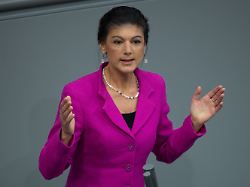It wasn’t until the beginning of January that the former left-wing politician Wagenknecht founded her new party, the BSW, which was named after her. The first successes can be seen in the surveys in less than three months. However, there is no major damage to the AfD.
With great media attention, Sahra Wagenknecht founded her party at the beginning of January – and a good two months later the start seems to have been successful. Initial surveys from East Germany show double-digit figures and, as Wagenknecht has just announced, far more people want to become members than she expected. This is also interesting in light of whether and to what extent the BSW is stealing votes from the AfD.
This is particularly relevant this year as there are four important elections. The European elections on June 9th will be followed by state elections in Thuringia and Saxony (both on September 1st) and in Brandenburg (on September 22nd) in September. The AfD is leading the polls in all three countries. But since the BSW was founded, something has started to move.
Example Thuringia: There the new party currently has 15 percent, as can be seen from the new “Thuringia Trend” by Infratest Dimap on behalf of the MDR. What’s remarkable is that the AfD loses five points, but remains the strongest force with 29 percent. However, the comparison period was a long time ago. The MDR last presented its “Thuringia Trend” in July of last year.
The numbers suggest that voters have switched from the AfD to the BSW – but it cannot be said whether this is actually the case; voter migration would have to be examined separately. Theoretically it is conceivable that the revelations about the right-wing extremist meeting in Potsdam or the observation by the Office for the Protection of the Constitution, the trial before the Münster Higher Administrative Court and the nationwide demonstrations against right-wing extremism could have damaged the AfD. It is also conceivable that the BSW will grow stronger at the expense of the left. It is obvious that the long-time left-wing politician Wagenknecht continues to be attractive to voters.
This is also indicated by surveys conducted by Insa on behalf of several Thuringian regional newspapers. The most recent survey, like the “Thüringen Trend”, only appeared this Tuesday and comes to similar results (BSW: 13, AfD 31). However, there are more recent comparison values from Insa, from January and November. One finding from this: Before the BSW was polled, the left there got 20 or more percent. When the BSW first appeared in the Insa survey in January, there were only 15 left.
In the new survey, however, this value grew again to 18, while the BSW fell from 17 to 13 percent. However, nothing has happened for the AfD in the past two months – it stood at 31 percent each time. Recently there have been movements mainly at BSW and the Left. But here, too, it is impossible to draw hasty conclusions – whether the votes really go from one party to another would have to be specifically investigated.
Example Saxony: Here, too, there is movement particularly among the Left and BSW, while the AfD remains the same. According to a new Insa survey commissioned by the “Bild” newspaper, the BSW also achieved a double-digit figure (11 percent), but nothing has happened with the AfD. With 34 percent, they are in the lead, ahead of the CDU with 30 percent. Things are different on the left. It almost halved compared to the last Insa survey last August, falling from 9 to 5 points. AfD and Union remained stable over the same period.
Example Brandenburg: There are no current surveys from this state. The most recent are from the beginning of January. On behalf of RTL and ntv, Forsa determined values for the AfD of 32 percent, the BSW was therefore 5 percent. Insa also created a survey for several regional newspapers at the beginning of January. The values are similar to those of Forsa – with the difference that the BSW comes to 13 percent. But there are hardly any movements between the Left, BSW and AfD. Trends can only be derived from more recent surveys.
Almost three months after the party was founded, the BSW is off to a good start and is reaching a considerable part of the electorate – although not necessarily at the expense of the AfD. The popularity of the BSW is not only reflected in surveys, but also among the members. Since the party was founded at the beginning of January, the BSW has been growing significantly faster than the party leadership said it expected. 1,000 were expected, said Wagenknecht on Tuesday at an appointment in Saarland. But 8,000 applications have now been submitted. The party currently has a good 500 members, and more than 17,000 people are registered as supporters.
This is remarkable, especially since the first regional association, in Saxony, was only founded at the end of February. Thuringia was added last Friday, and this Friday the company will be founded in Saarland. “This is also due to the fact that we are running for local elections in individual districts,” said Wagenknecht. The next company will be founded in Brandenburg at the beginning of May at the latest. “We had more time because we didn’t run for local elections with our own lists, but rather our members ran in local alliances.”
At the federal level, the BSW can also hope to enter the Bundestag next year. In the trend barometer from RTL and ntv, the party currently achieves the five percent required for this. The AfD is at 17 percent, six points below its highest level to date in mid-December.
